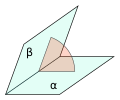Dihedral angle
Dihedral angle refers to the angle formed between two intersecting planes in three-dimensional space. In the context of chemistry and molecular biology, dihedral angles are crucial for understanding the three-dimensional structures of molecules and proteins, influencing their properties and interactions. In mathematics and engineering, dihedral angles play a significant role in the study of polyhedra and the design of various structures.
Definition[edit]
A dihedral angle is defined as the angle between two planes, which can be determined by selecting two intersecting lines, one from each plane, and measuring the angle between these lines. This angle provides a measure of the spatial orientation between the two planes. In a more practical sense, in molecular geometry, it is the angle between two planes formed by three atoms each, with two atoms shared between the planes.
Measurement[edit]
The measurement of dihedral angles can be performed using various methods, depending on the context. In molecular biology, computational tools and X-ray crystallography are commonly used to determine the angles between atoms in a molecule. In engineering and mathematics, geometric principles and tools like protractors or computational models are employed.
Importance in Molecular Biology[edit]
In molecular biology, dihedral angles, also known as torsion angles, are essential for understanding the conformation of biomolecules. These angles influence the folding and function of proteins, the double helix structure of DNA, and the efficacy of drug molecules. The Ramachandran plot, a tool used to visualize the conformational space of amino acids in proteins, is based on the phi (φ) and psi (ψ) dihedral angles.
Applications in Chemistry[edit]
In chemistry, dihedral angles are important for predicting the physical and chemical properties of molecules. The angle affects the molecule's polarity, reactivity, and overall shape, which in turn influences its interactions with other molecules. Understanding dihedral angles is crucial for the design of new pharmaceuticals and materials.
Engineering and Design[edit]
In the field of engineering, dihedral angles are important in the design of mechanical joints, bridges, and architectural structures. They determine the stability and stress distribution within the structure. In aerospace engineering, the dihedral angle of an airplane's wings significantly affects its aerodynamic properties and stability during flight.
Mathematical Significance[edit]
Dihedral angles are also of interest in pure mathematics, particularly in the study of polyhedra and tessellations. They are key to understanding the geometry and symmetry of three-dimensional shapes.
See Also[edit]
|
|
|

This article is a geometry-related stub. You can help WikiMD by expanding it!

This article is a molecular biology stub. You can help WikiMD by expanding it!
-
Dihedral angle illustration
-
Spherical bond dihedral angle
-
Synantipericlinal conformation
-
Newman projection of butane
-
Sawhorse projection of butane
-
Dihedral angles of Butane
-
Protein backbone Phi, Psi, Omega angles
Ad. Transform your life with W8MD's Budget GLP-1 injections from $75


W8MD offers a medical weight loss program to lose weight in Philadelphia. Our physician-supervised medical weight loss provides:
- Weight loss injections in NYC (generic and brand names):
- Zepbound / Mounjaro, Wegovy / Ozempic, Saxenda
- Most insurances accepted or discounted self-pay rates. We will obtain insurance prior authorizations if needed.
- Generic GLP1 weight loss injections from $75 for the starting dose.
- Also offer prescription weight loss medications including Phentermine, Qsymia, Diethylpropion, Contrave etc.
NYC weight loss doctor appointmentsNYC weight loss doctor appointments
Start your NYC weight loss journey today at our NYC medical weight loss and Philadelphia medical weight loss clinics.
- Call 718-946-5500 to lose weight in NYC or for medical weight loss in Philadelphia 215-676-2334.
- Tags:NYC medical weight loss, Philadelphia lose weight Zepbound NYC, Budget GLP1 weight loss injections, Wegovy Philadelphia, Wegovy NYC, Philadelphia medical weight loss, Brookly weight loss and Wegovy NYC
|
WikiMD's Wellness Encyclopedia |
| Let Food Be Thy Medicine Medicine Thy Food - Hippocrates |
Medical Disclaimer: WikiMD is not a substitute for professional medical advice. The information on WikiMD is provided as an information resource only, may be incorrect, outdated or misleading, and is not to be used or relied on for any diagnostic or treatment purposes. Please consult your health care provider before making any healthcare decisions or for guidance about a specific medical condition. WikiMD expressly disclaims responsibility, and shall have no liability, for any damages, loss, injury, or liability whatsoever suffered as a result of your reliance on the information contained in this site. By visiting this site you agree to the foregoing terms and conditions, which may from time to time be changed or supplemented by WikiMD. If you do not agree to the foregoing terms and conditions, you should not enter or use this site. See full disclaimer.
Credits:Most images are courtesy of Wikimedia commons, and templates, categories Wikipedia, licensed under CC BY SA or similar.
Translate this page: - East Asian
中文,
日本,
한국어,
South Asian
हिन्दी,
தமிழ்,
తెలుగు,
Urdu,
ಕನ್ನಡ,
Southeast Asian
Indonesian,
Vietnamese,
Thai,
မြန်မာဘာသာ,
বাংলা
European
español,
Deutsch,
français,
Greek,
português do Brasil,
polski,
română,
русский,
Nederlands,
norsk,
svenska,
suomi,
Italian
Middle Eastern & African
عربى,
Turkish,
Persian,
Hebrew,
Afrikaans,
isiZulu,
Kiswahili,
Other
Bulgarian,
Hungarian,
Czech,
Swedish,
മലയാളം,
मराठी,
ਪੰਜਾਬੀ,
ગુજરાતી,
Portuguese,
Ukrainian










